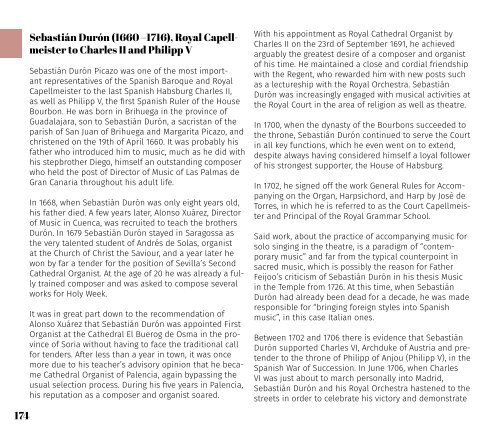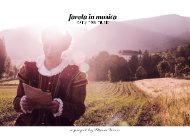Booklet "favola in musica.alte neue musik"
Enjoy the 216 pages fairy tale book inspired booklet of "favola in musica. early new music" in German and English with over 100 photographs, well researched musical texts to each aria, translations of all aria texts in German and English and biographies of all participating members. Music from renaissance, baroque and present time - 3 world premiere recordings from early music (Antonio Caldara, Sebastian Durón) - 2 world premiere recordings of contemporary music (Wolfgang Mitterer) - 1 bonus music-video (included on the CD) Deluxe Edition in a high-quality CD-Hardcover-Digibook, 216 costly designed pages with photos and texts 1607. ensemble for early & new music: Maria Weiss, voice, artistic director Rosario Conte, theorbo Gyöngy Erödi, cello Wolfgang Mitterer, composer Awarded the Pasticciopreis 2015 in Radio Österreich 1 »favola in musica« (eng. fairy tale in music) is the debut-album of the mezzo-soprano Maria Weiss, who designed this album as a musical fairy taie. It is the searching for the New within the Old and for the Old within the New. Developing this album,Maria Weiss lifted some treasures to light, so e.g. she discovered in the archives an aria of the forgotten opera of the composer Antonio Caldara. She also asked the composer and performer Wolfgang Mitterer, to reate two new works for this album. If you engage into this musical journey, you can also find the words of Monteverdis L'Orfeo but in an competely new contemporary way. Enjoy!
Enjoy the 216 pages fairy tale book inspired booklet of "favola in musica. early new music" in German and English with over 100 photographs, well researched musical texts to each aria, translations of all aria texts in German and English and biographies of all participating members.
Music from renaissance, baroque and present time
- 3 world premiere recordings from early music (Antonio Caldara, Sebastian Durón)
- 2 world premiere recordings of contemporary music (Wolfgang Mitterer)
- 1 bonus music-video (included on the CD)
Deluxe Edition in a high-quality CD-Hardcover-Digibook, 216 costly designed pages with photos and texts
1607. ensemble for early & new music:
Maria Weiss, voice, artistic director
Rosario Conte, theorbo
Gyöngy Erödi, cello
Wolfgang Mitterer, composer
Awarded the Pasticciopreis 2015 in Radio Österreich 1
»favola in musica« (eng. fairy tale in music) is the debut-album of the mezzo-soprano Maria Weiss, who designed this album as a musical fairy taie. It is the searching for the New within the Old and for the Old within the New. Developing this album,Maria Weiss lifted some treasures to light, so e.g. she discovered in the archives an aria of the forgotten opera of the composer Antonio Caldara. She also asked the composer and performer Wolfgang Mitterer, to reate two new works for this album. If you engage into this musical journey, you can also find the words of Monteverdis L'Orfeo but in an competely new contemporary way. Enjoy!
Erfolgreiche ePaper selbst erstellen
Machen Sie aus Ihren PDF Publikationen ein blätterbares Flipbook mit unserer einzigartigen Google optimierten e-Paper Software.
174<br />
Sebastián Durón (1660 –1716), Royal Capellmeister<br />
to Charles II and Philipp V<br />
Sebastián Durón Picazo was one of the most important<br />
representatives of the Spanish Baroque and Royal<br />
Capellmeister to the last Spanish Habsburg Charles II,<br />
as well as Philipp V, the first Spanish Ruler of the House<br />
Bourbon. He was born <strong>in</strong> Brihuega <strong>in</strong> the prov<strong>in</strong>ce of<br />
Guadalajara, son to Sebastián Durón, a sacristan of the<br />
parish of San Juan of Brihuega and Margarita Picazo, and<br />
christened on the 19th of April 1660. It was probably his<br />
father who <strong>in</strong>troduced him to music, much as he did with<br />
his stepbrother Diego, himself an outstand<strong>in</strong>g composer<br />
who held the post of Director of Music of Las Palmas de<br />
Gran Canaria throughout his adult life.<br />
In 1668, when Sebastián Durón was only eight years old,<br />
his father died. A few years later, Alonso Xuárez, Director<br />
of Music <strong>in</strong> Cuenca, was recruited to teach the brothers<br />
Durón. In 1679 Sebastián Durón stayed <strong>in</strong> Saragossa as<br />
the very talented student of Andrés de Solas, organist<br />
at the Church of Christ the Saviour, and a year later he<br />
won by far a tender for the position of Sevilla’s Second<br />
Cathedral Organist. At the age of 20 he was already a fully<br />
tra<strong>in</strong>ed composer and was asked to compose several<br />
works for Holy Week.<br />
It was <strong>in</strong> great part down to the recommendation of<br />
Alonso Xuárez that Sebastián Durón was appo<strong>in</strong>ted First<br />
Organist at the Cathedral El Buerog de Osma <strong>in</strong> the prov<strong>in</strong>ce<br />
of Soria without hav<strong>in</strong>g to face the traditional call<br />
for tenders. After less than a year <strong>in</strong> town, it was once<br />
more due to his teacher’s advisory op<strong>in</strong>ion that he became<br />
Cathedral Organist of Palencia, aga<strong>in</strong> bypass<strong>in</strong>g the<br />
usual selection process. Dur<strong>in</strong>g his five years <strong>in</strong> Palencia,<br />
his reputation as a composer and organist soared.<br />
With his appo<strong>in</strong>tment as Royal Cathedral Organist by<br />
Charles II on the 23rd of September 1691, he achieved<br />
arguably the greatest desire of a composer and organist<br />
of his time. He ma<strong>in</strong>ta<strong>in</strong>ed a close and cordial friendship<br />
with the Regent, who rewarded him with new posts such<br />
as a lectureship with the Royal Orchestra. Sebastián<br />
Durón was <strong>in</strong>creas<strong>in</strong>gly engaged with <strong>musica</strong>l activities at<br />
the Royal Court <strong>in</strong> the area of religion as well as theatre.<br />
In 1700, when the dynasty of the Bourbons succeeded to<br />
the throne, Sebastián Durón cont<strong>in</strong>ued to serve the Court<br />
<strong>in</strong> all key functions, which he even went on to extend,<br />
despite always hav<strong>in</strong>g considered himself a loyal follower<br />
of his strongest supporter, the House of Habsburg.<br />
In 1702, he signed off the work General Rules for Accompany<strong>in</strong>g<br />
on the Organ, Harpsichord, and Harp by José de<br />
Torres, <strong>in</strong> which he is referred to as the Court Capellmeister<br />
and Pr<strong>in</strong>cipal of the Royal Grammar School.<br />
Said work, about the practice of accompany<strong>in</strong>g music for<br />
solo s<strong>in</strong>g<strong>in</strong>g <strong>in</strong> the theatre, is a paradigm of “contemporary<br />
music” and far from the typical counterpo<strong>in</strong>t <strong>in</strong><br />
sacred music, which is possibly the reason for Father<br />
Feijoo’s criticism of Sebastián Durón <strong>in</strong> his thesis Music<br />
<strong>in</strong> the Temple from 1726. At this time, when Sebastián<br />
Durón had already been dead for a decade, he was made<br />
responsible for “br<strong>in</strong>g<strong>in</strong>g foreign styles <strong>in</strong>to Spanish<br />
music”, <strong>in</strong> this case Italian ones.<br />
Between 1702 and 1706 there is evidence that Sebastián<br />
Durón supported Charles VI, Archduke of Austria and pretender<br />
to the throne of Philipp of Anjou (Philipp V), <strong>in</strong> the<br />
Spanish War of Succession. In June 1706, when Charles<br />
VI was just about to march personally <strong>in</strong>to Madrid,<br />
Sebastián Durón and his Royal Orchestra hastened to the<br />
streets <strong>in</strong> order to celebrate his victory and demonstrate





